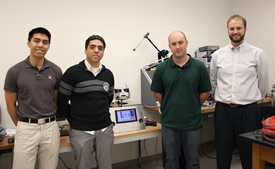A team of Cullen College engineering students presented their senior design project this month, unveiling the next-generation RoboShasta, a UH mascot "bot." The semester-long project culminated in an advanced version of an existing anima-tronic-inspired cougar.
The team, comprised of Kasey Herman, David Aguilar, Tim Sweet, and Andrew Luu, developed the bot with a purpose beyond the specifications set forth by Professor John Glover's course. RoboShasta can interact with humans. It is trained to track colors and objects. It has a manual mode, a female voice, and a sense of humor.
"Our focus was to make RoboShasta simple for anyone to use," said Kasey Herman, project team leader. "You don't need to be an engineer to use it." The computerized cat was built with a user-friendly LCD interface that resembles a PC desktop. A clear chassis casing shows its inner workings, which are backlit with LEDs.
A user manual gives instructions for operating RoboShasta's various functions, although the machine is intuitive. "It works just like a computer," Kasey said. "Once you plug it in, there's one power switch on the back and in 20 seconds the LCD interface pops up and you're ready to go."
Upon boot-up, RoboShasta's camera configuration adjusts to ambient light conditions. That's important because RoboShasta tracks objects based on color and shape. "In different lighting conditions the camera sees different colors, which is why we optimized that for the predetermined colors that we set," said Kasey. As her eyes are adjusting, RoboShasta says, "Please wait a moment while I put in my contacts."
RoboShasta also has a manual mode in which a wireless controller can make her growl and move her eyes, among other actions, from up to 30 feet away. Another fun feature is RoboShasta's object recognition ability. She scans pictures from a safari book, and reacts based on what she sees. Upon noticing a picture of a lion, RoboShasta responds with good-natured cat spirit: "I found the king of the jungle. I can take him."
"You can train it to find new images," Kasey said. "It scans all of the video that it's been receiving, and finds the images that we've saved." Going forward, this feature might become the building block to facial recognition.
In demonstration mode, RoboShasta gives facts about the University and the Cullen College. As a mechanized ambassador, RoboShasta may find herself at college recruiting events, engaging new students with information and wit. She is a salient representation of what Cullen College students can accomplish.
Several companies contributed to the RoboShasta build. Tom Filban at Toshiba International Corp. supplied the custom-designed case; Neil Manchester of Sani-Weld Inc. fabricated custom designs for the mask, cradle, and jaw, material and labor costs; and Brett Parrish and NASA donated the Arduino microcontroller.
